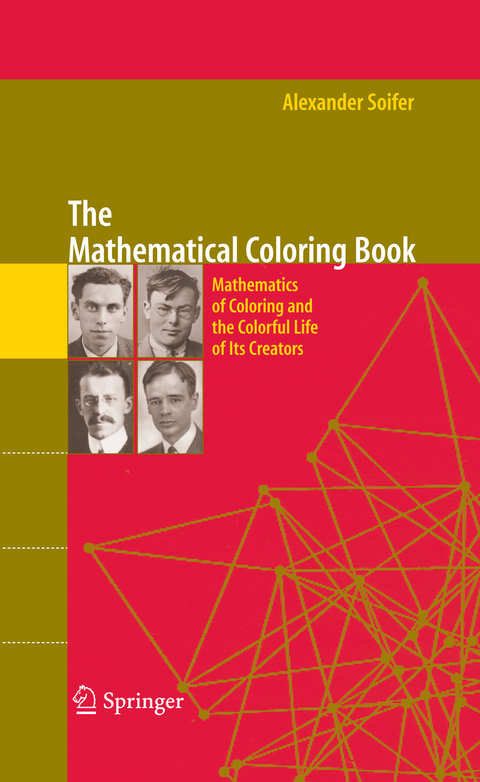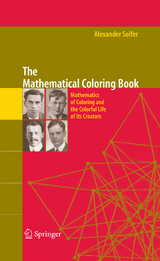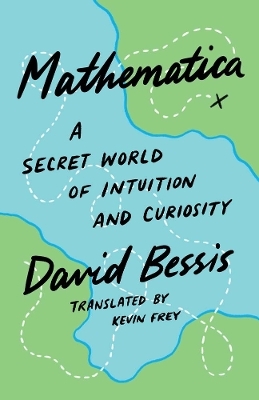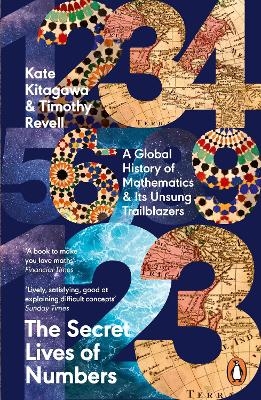The Mathematical Coloring Book
Springer-Verlag New York Inc.
978-0-387-74640-1 (ISBN)
- Titel ist leider vergriffen;
keine Neuauflage - Artikel merken
Alexander Soifer is a Russian born and educated American mathematician, a professor of mathematics at the University of Colorado, an author of some 200 articles on mathematics, history of mathematics, mathematics education, film reviews, etc. He is Senior Vice President of the World Federation of National Mathematics Competitions, which in 2006 awarded him The Paul Erdös Award. 26 years ago Soifer founded has since chaired The Colorado Mathematical Olympiad, and served on both USSR and USA Mathematical Olympiads committees. Soifer’s Erdös number is 1. Springer has contracted his 7 books. "The Mathematical Coloring Book" is coming out in October 2008; 4 books will appear in 2009; followed by "Life and Fate: In Search of Van der Waerden", and a joint book with the late Paul Erdos “Problems of p.g.o.m. Erdos." The author's previous books were self-published and received many positive reviews, below are excerpts from reviews of "How Does One Cut A Triangle?: "Why am I urging you to read this? Mainly because it is such a refreshing book. Professor Soifer makes the problems fascinating, the methods of attack even more fascinating, and the whole thing is enlivened by anecdotes about the history of the problems, some of their recent solvers, and the very human reactions of the author to some beautiful mathematics. Most of all, the book has charm, somehow enhanced by his slightly eccentric English, sufficient to carry the reader forward without minding being asked to do rather a lot of work. I am tempted to include several typical quotations but I'll restrain myself to two: From Chapter 8 "Here is an easy problem for your entertainment. Problem 8.1.2. Prove that for any parallelogram P, S(P)=5. Now we have a new problem, therefore we are alive! And the problem is this: what are all possible values of our newly introduced function S(F)? Can the function S(F) help us to classify geometry figures?" Andfrom an introduction by Cecil Rousseau: ‘There is a view, held by many, that mathematics books are dull. This view is not without support. It is reinforced by numerous examples at all levels, from elementary texts with page after page of mind-numbing drill to advanced books written in a relentless Theorem-Proof style. "How does one cut a triangle?" is an entirely different matter. It reads like an adventure story. In fact, it is an adventure story, complete with interesting characters, moments of exhilaration, examples of serendipity, and unanswered questions. It conveys the spirit of mathematical discovery and it celebrates the event as have mathematicians throughout history.’ And this isn't just publishers going over the top - it's all true!" -- JOHN Baylis in The Mathematical Gazette Soifer's work can rightly be called a "mathematical gem." -- JAMES N. BOYD in Mathematics Teacher This delightful bookconsiders and solves many problems in dividing triangles into n congruent pieces and also into similar pieces, as well as many extremal problems about placing points in convex figures. The book is primarily meant for clever high school students and college students interested in geometry, but even mature mathematicians will find a lot of new material in it. I very warmly recommend the book and hope the readers will have pleasure in thinking about the unsolved problems and will find new ones. -- PAUL ERDÖS It is impossible to convey the spirit of the book by merely listing the problems considered or even a number of solutions. The manner of presentation and the gentle guidance toward a solution and hence to generalizations and new problems takes this elementary treatise out of the prosaic and into the stimulating realm of mathematical creativity. Not only young talented people but dedicated secondary teachers and even a few mathematical sophisticates will findthis reading both pleasant and profitable. -- L. M. KELLY in Mathematical Reviews We do not often have possibilities to look into a creative workshop of a mathematician... The beginner, who is interested in the book, not only comprehends a situation in a creative mathematical studio, not only is exposed to good mathematical taste, but also acquires elements of modern mathematical culture. And (not less important) the reader imagines the role and place of intuition and analogy in mathematical investigation; he or she fancies the meaning of generalization in modern mathematics and surprising connections between different parts of this science (that are, as one might think, far from each other) that unite them... This makes the book alive, fresh, and easily readable. Alexander Soifer has produced a good gift for the young lover of mathematics. And not only for youngsters; the book should be interesting even to professional mathematicians. V. G. BOLTYANSKI in SIAM Review
Merry-Go-Round.- A Story of Colored Polygons and Arithmetic Progressions.- Colored Plane.- Chromatic Number of the Plane: The Problem.- Chromatic Number of the Plane: An Historical Essay.- Polychromatic Number of the Plane and Results Near the Lower Bound.- De Bruijn–Erd?s Reduction to Finite Sets and Results Near the Lower Bound.- Polychromatic Number of the Plane and Results Near the Upper Bound.- Continuum of 6-Colorings of the Plane.- Chromatic Number of the Plane in Special Circumstances.- Measurable Chromatic Number of the Plane.- Coloring in Space.- Rational Coloring.- Coloring Graphs.- Chromatic Number of a Graph.- Dimension of a Graph.- Embedding 4-Chromatic Graphs in the Plane.- Embedding World Records.- Edge Chromatic Number of a Graph.- Carsten Thomassen’s 7-Color Theorem.- Coloring Maps.- How the Four-Color Conjecture Was Born.- Victorian Comedy of Errors and Colorful Progress.- Kempe–Heawood’s Five-Color Theorem and Tait’s Equivalence.- The Four-Color Theorem.- The GreatDebate.- How Does One Color Infinite Maps? A Bagatelle.- Chromatic Number of the Plane Meets Map Coloring: Townsend–Woodall’s 5-Color Theorem.- Colored Graphs.- Paul Erd?s.- De Bruijn–Erd?s’s Theorem and Its History.- Edge Colored Graphs: Ramsey and Folkman Numbers.- The Ramsey Principle.- From Pigeonhole Principle to Ramsey Principle.- The Happy End Problem.- The Man behind the Theory: Frank Plumpton Ramsey.- Colored Integers: Ramsey Theory Before Ramsey and Its AfterMath.- Ramsey Theory Before Ramsey: Hilbert’s Theorem.- Ramsey Theory Before Ramsey: Schur’s Coloring Solution of a Colored Problem and Its Generalizations.- Ramsey Theory before Ramsey: Van der Waerden Tells the Story of Creation.- Whose Conjecture Did Van der Waerden Prove? Two Lives Between Two Wars: Issai Schur and Pierre Joseph Henry Baudet.- Monochromatic Arithmetic Progressions: Life After Van der Waerden.- In Search of Van der Waerden: The Early Years.- In Search of Van der Waerden: The Nazi Leipzig, 1933–1945.- In Search of Van der Waerden: The Postwar Amsterdam, 1945166.- In Search of Van der Waerden: The Unsettling Years, 1946–1951.- Colored Polygons: Euclidean Ramsey Theory.- Monochromatic Polygons in a 2-Colored Plane.- 3-Colored Plane, 2-Colored Space, and Ramsey Sets.- Gallai’s Theorem.- Colored Integers in Service of Chromatic Number of the Plane: How O’Donnell Unified Ramsey Theory and No One Noticed.- Application of Baudet–Schur–Van der Waerden.- Application of Bergelson–Leibman’s and Mordell–Faltings’ Theorems.- Solution of an Erd?s Problem: O’Donnell’s Theorem.- Predicting the Future.- What If We Had No Choice?.- A Glimpse into the Future: Chromatic Number of the Plane, Theorems and Conjectures.- Imagining the Real, Realizing the Imaginary.- Farewell to the Reader.- Two Celebrated Problems.
| Vorwort | Branko Grünbaum, Peter Johnson, Cecil Rousseau |
|---|---|
| Zusatzinfo | 10 Illustrations, color; 343 Illustrations, black and white; XXX, 607 p. 353 illus., 10 illus. in color. |
| Verlagsort | New York, NY |
| Sprache | englisch |
| Maße | 155 x 235 mm |
| Themenwelt | Mathematik / Informatik ► Mathematik ► Geschichte der Mathematik |
| Mathematik / Informatik ► Mathematik ► Graphentheorie | |
| Mathematik / Informatik ► Mathematik ► Logik / Mengenlehre | |
| Mathematik / Informatik ► Mathematik ► Wahrscheinlichkeit / Kombinatorik | |
| ISBN-10 | 0-387-74640-4 / 0387746404 |
| ISBN-13 | 978-0-387-74640-1 / 9780387746401 |
| Zustand | Neuware |
| Informationen gemäß Produktsicherheitsverordnung (GPSR) | |
| Haben Sie eine Frage zum Produkt? |
aus dem Bereich




